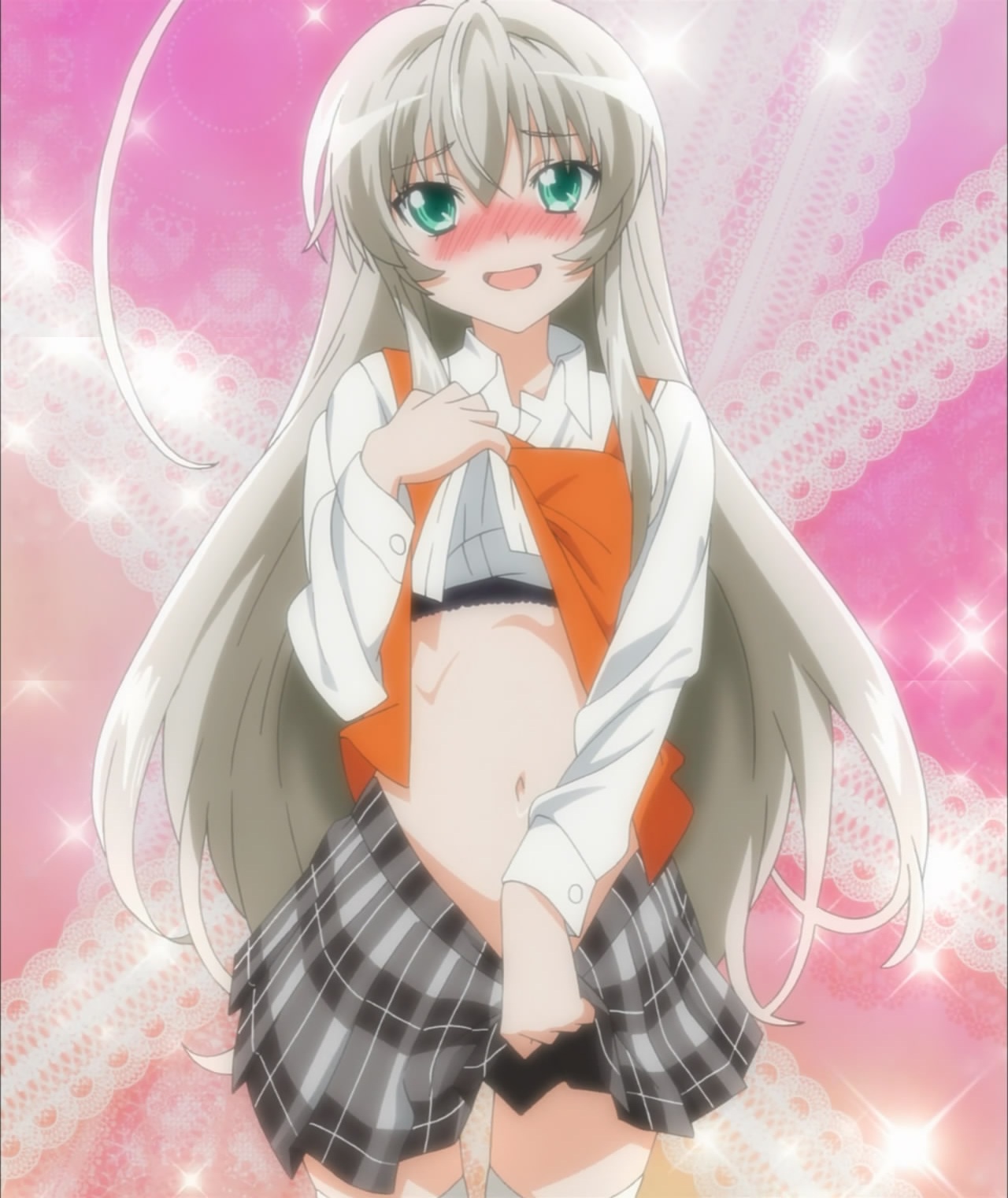Haiyore! Nyaruko-san Episode 3 References
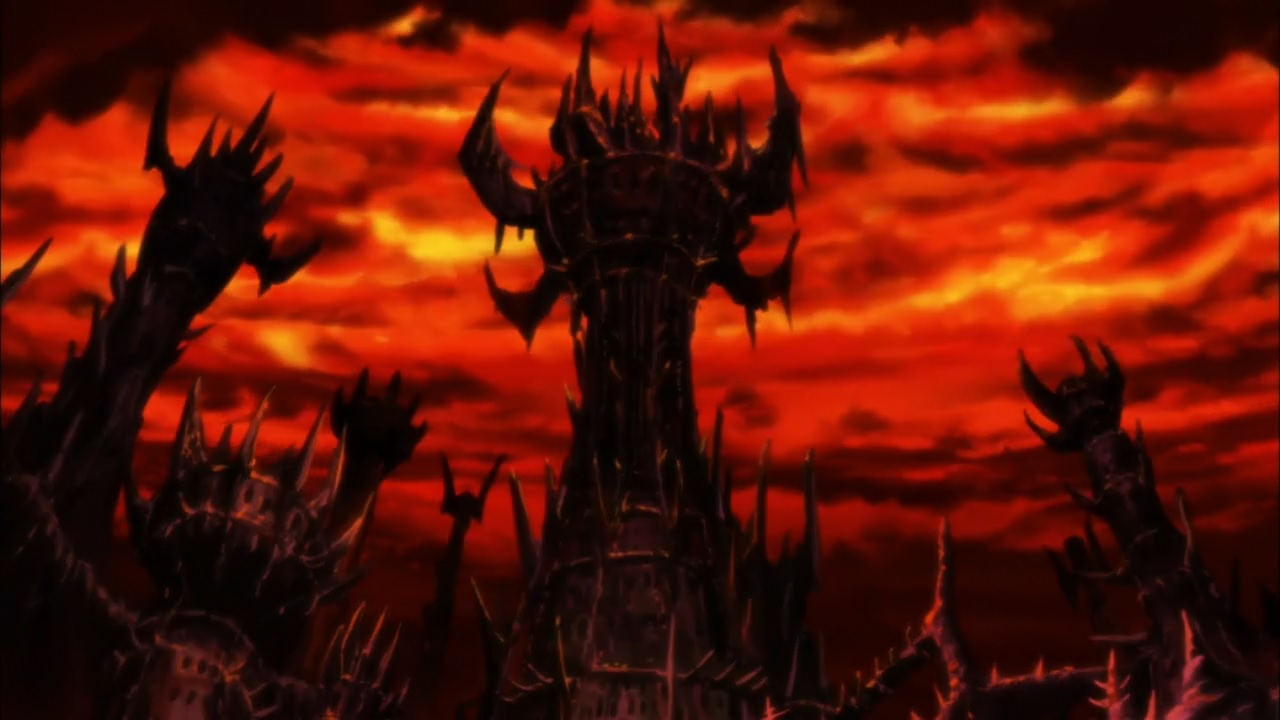
(0:06)
The castle here is referencing "The Dream-Quest of Unknown Kadath", a story written by H. P. Lovecraft and published in 1943. In the story, the Great Ones, a species of creature in the Cthulhu Mythos, are said to dwell in an onyx castle.S9
"Gods of Earth, how unfortunate for you" (0:16)
The phrase "Chikyuu no kamigami" (地球の神々), "Gods of Earth", is referencing the Great Ones, a species of creature in the Cthulhu Mythos.S9 In "The Dream-Quest of Unknown Kadath", a story written by H. P. Lovecraft and published in 1943, they are described as follows:
"... they are indeed only earth's gods, ruling feebly our own dreamland and having no power or habitation elsewhere."
(0:42)
There are three references here:
• Nyaruko suggests calling Mahiro "Niini" (にぃに), which means "older brother" in Japanese. This is referencing Tachibana Miya (橘美也) from "Amagami" (アマガミ), "Gentle Bite", a visual novel released by Enterbrain (エンターブレイン) in 2009. In the visual novel, Miya is the younger sister of the main character, Tachibana Junichi (橘純一), and she calls him "Niini" (にぃに).
• Nyaruko's voice actor, Asumi Kana (阿澄佳奈), also voices Miya.
• This visual novel was adapted into an anime series in 2010 as "Amagami SS" (アマガミSS), and in 2012 as "Amagami SS+ plus" (アマガミSS+ plus). Two of the people who write the episode scripts for "Haiyore! Nyaruko-san", Kimura Noboru (木村暢) and Machida Touko (待田堂子), also have written the scripts for several episodes of both anime adaptations of "Amagami". In addition, Kimura Noboru was in charge of the series composition (シリーズ構成) for both "Haiyore! Nyaruko-san" and "Amagami SS+ plus".S1
(0:48)
There are three references here:
• Nyaruko suggests calling Mahiro "Mahiro-chan" (真尋ちゃん). In Japanese, "chan" is an honorific used typically to express that the speaker finds a person endearing. This is referencing Sado Shizuka (砂戸静香) from "MM!" (えむえむっ!), a light novel series written by Matsuno Akinari (松野秋鳴) and published from 2007 to 2010. In the series, Shizuka is the older sister of the main character, Sado Tarou (砂戸太郎), and calls him "Tarou-chan" (太郎ちゃん).
• This light novel series was adapted into an anime series in 2010. In this anime series, Nyaruko's voice actor, Asumi Kana (阿澄佳奈), also voices Shizuka.
• The anime adaptations of "MM!" and "Haiyore! Nyaruko-san" were both animated by the same studio, Xebec (ジーベック).S1 In addition, both anime adaptations were directed by Nagasawa Tsuyoshi (長澤剛).S7 Furthermore, the person who wrote the script for episode 3 of "Haiyore! Nyaruko-san", Ishida Takeyuki (石田健幸), also worked on "MM!" as a production assistant (制作進行) and script manager (文芸).
"I'm not a pervert or a masochist!" (1:05)
The Japanese line is "Boku ha hentai shinshi demo do emu demo nai!" (僕は変態紳士でもドMでもない!). In response to the previous two sets of references, there are two references here:
• The main character of "Amagami" (アマガミ), Tachibana Junichi (橘純一), was nicknamed "hentai shinshi" (変態紳士), "perverted gentleman", by fans because of how in general he is well-mannered and gentlemanly, but he also has strange preferences.S1
• The main character of "MM!" (えむえむっ!), Sado Tarou (砂戸太郎), is a masochist.S1
"Pazuzu!" (1:07)
There are two references here:
* Pazuzu (パズズ) is a creature that appears in "Shin Megami Tensei II" (真・女神転生II), "True Goddess Reincarnation 2", a video game released by ATLUS (アトラス) in 1994.S1 In this game, Pazuzu is in a classification called "jashin" (邪神), "evil god". This is the same term used in Japanese to generally refer to creatures known as "Great Old Ones" in the Cthulhu Mythos. On a related note, Nyarlathotep and Cthulhu also appear in this game, and they are also in this classification. The only other creatures in this classification in this game are Tezcatlipoca and Naragiri, which are what Nyaruo yelps later in this episode.S1
* In the Cthulhu Mythos, Pazzuzu is an avatar of Nyarlathotep.S9 It appears in "Last Rites", a book containing supplemental material for the "Call of Cthulhu" RPG published by Chaosium in 1999.
"Plateau of Sung" (3:10)
When Mahiro grabs Nyaruko's face, she says "Sun Kougen" (スン高原), which translates to "Plateau of Sung". The Plateau of Sung is a fictional location in the Cthulhu Mythos that appears in "The Lair of the Star-Spawn", a short story written by August Derleth and first published in 1932.S9
"I don't need a little sister that has a thousand faces!" (3:12)
This is referencing how in the Cthulhu Mythos Nyarlathotep claims to have a thousand different forms.S1 In "The Dream-Quest of Unknown Kadath", a story written by H. P. Lovecraft and published in 1943, Nyarlathotep says the following:
"... pray to all space that you may never meet me in my thousand other forms. Farewell, Randolph Carter, and beware; for I am Nyarlathotep, the Crawling Chaos!"
"Could this capricious behavior come from the cursed evil god hunter of the Black Book?" (3:19)
There are two references here:
* "Kindan no Kuro no Sho" (禁断の黒の書), "forbidden black book", is referencing the Unaussprechlichen Kulten, a fictional book from the Cthulhu Mythos. It is also known as "Kuro no Sho" (黒の書), "Black Book".S3
* This is referencing "Jashin Hantaa" (邪神ハンター), "Evil God Hunter", a light novel series written by Izumi Makoto (出海まこと) and published in 1998. In addition, creatures from the Cthulhu Mythos appear in this series.S5
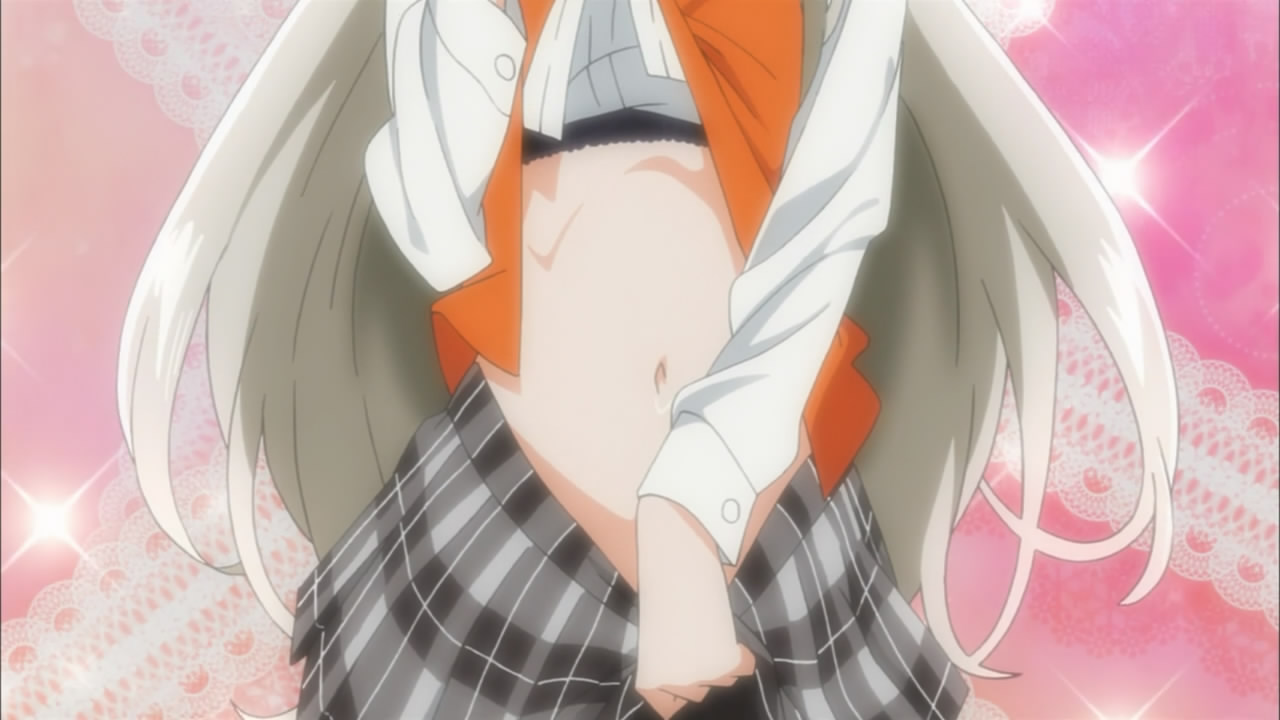
(4:42)
Nyaruko's pose is referencing the same pose done by Tanamachi Kaoru (棚町薫) in "Amagami" (アマガミ). This same scene was depicted in episode 6 of the anime adaptation that aired in 2010. Image for reference:
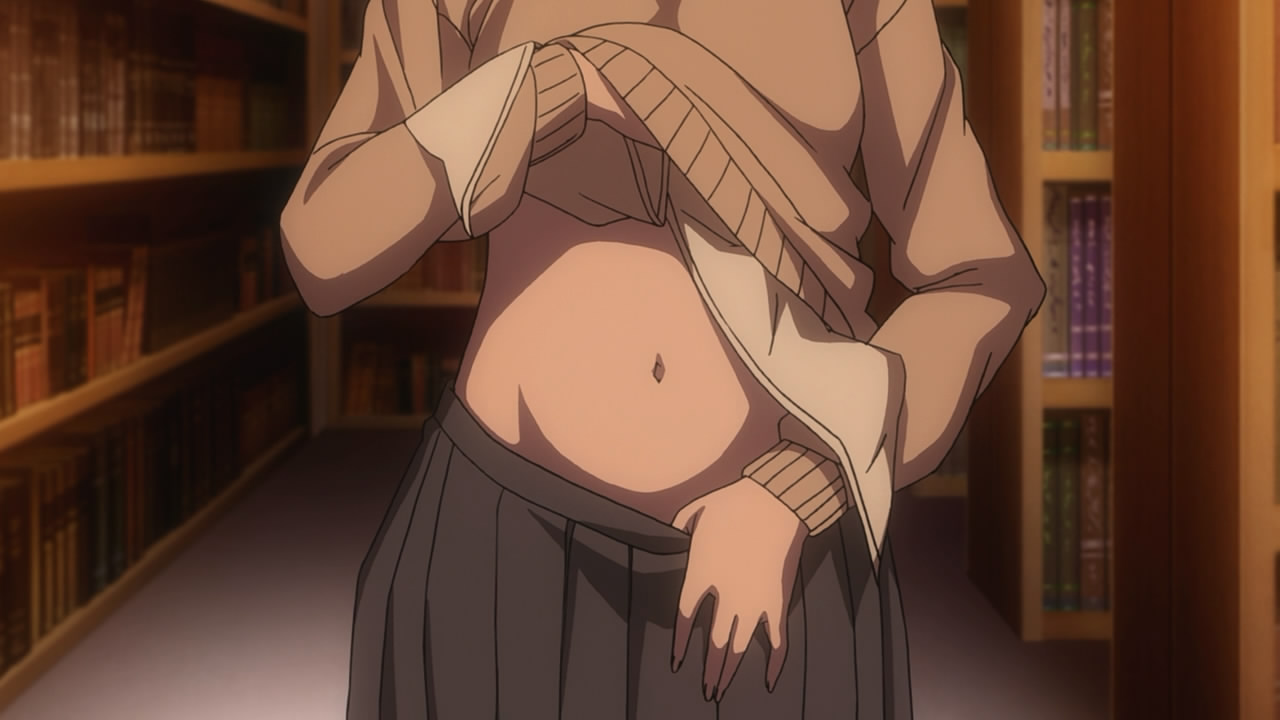
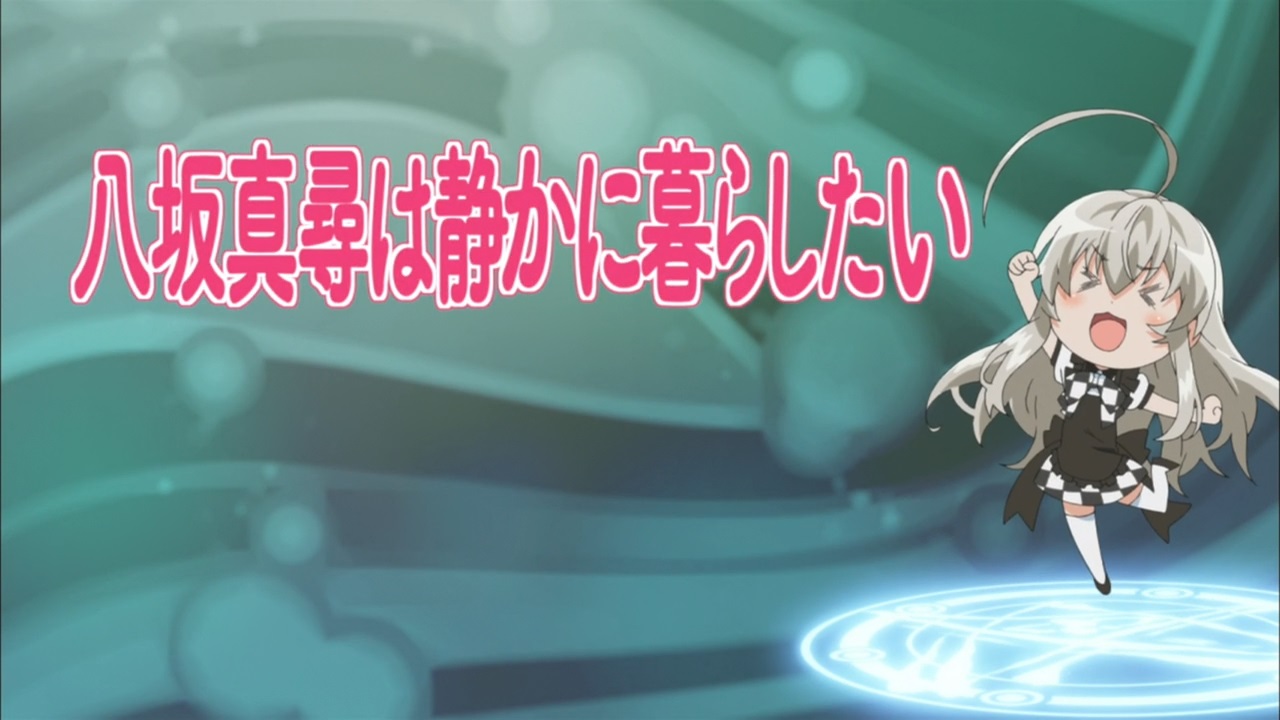
(4:56)
The title of this episode is "Yasaka Mahiro ha Shizuka ni Kurashitai" (八坂真尋は静かに暮らしたい), which translates to "Yasaka Mahiro Wants to Live in Peace". This is referencing "Jojo no Kimyou na Bouken" (ジョジョの奇妙な冒険), "Jojo's Bizarre Adventure", a manga series written by Araki Hirohiko (荒木飛呂彦) and published starting from 1987. The subtitle of volume 37 of this series is "Kira Yoshikage ha Shizuka ni Kurashitai" (吉良吉影は静かに暮らしたい), which translates to "Kira Yosikage Wants to Live in Peace".S3 Image for reference:


(5:21)
As mentioned in episode 2 at 19:56, the tower is based on the West Tokyo Sky Tower (西東京スカイタワー), also known as Tanashi Tower (田無タワー). Picture for reference:
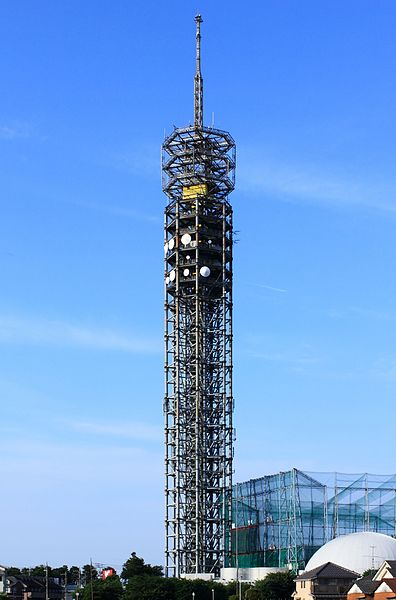
Source of image: https://ja.wikipedia.org/wiki/ファイル:SkyTower_NishiTokyo.JPG
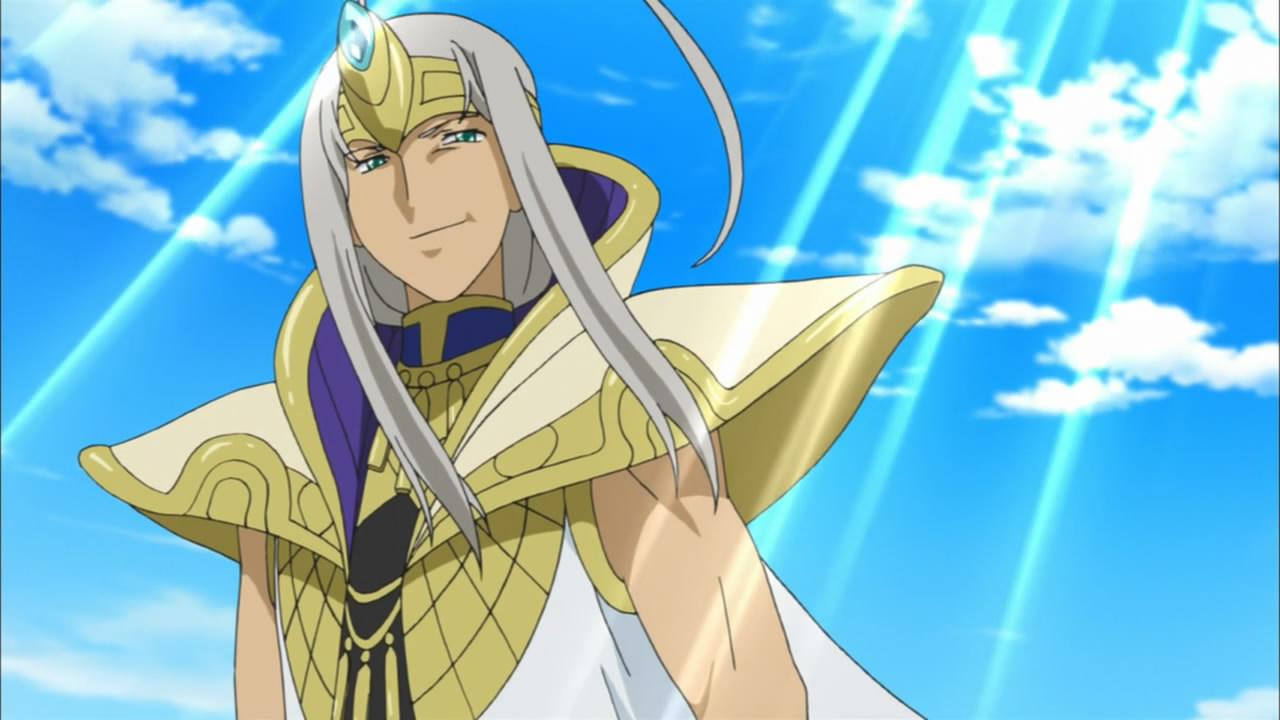
(5:27)
The clothes Nyaruo (ニャル夫) wears resemble that of Egyptian pharaohs. This is referencing how Nyarlathotep has various connections to Egypt and Pharaohs:
* Nyarlathotep's name has been noted for having the Egyptian suffix -hotep.
* An avatar of Nyarlathotep appears in this form in "The Dream-Quest of Unknown Kadath", a story written by H. P. Lovecraft and first published in 1943.S9 In the story, the avatar is described as follows:
"Then down the wide lane betwixt the two columns a lone figure strode; a tall, slim figure with the young face of an antique Pharaoh, gay with prismatic robes and crowned with a golden pshent that glowed with inherent light."
Nyaruko's laugh (5:43)
Nyaruko says "Dufufu" (デュフフ), which is a way of laughing and is popularly used internet slang. This way of laughing is associated with otaku.S4 Otaku is a term used to describe people with obsessive interests.

"What of it?" (6:16)
The Japanese text is "Desu ga nani ka?" (ですが何か?), which is a popular phrase on 2ch and other Japanese discussion boards.S3
"Keep it to three lines." (7:14)
The Japanese line is "San gyou de tanomu" (3行で頼む). This is a popular phrase used on 2ch and other Japanese discussion boards. It is usually used in response to a person who just wrote a long post.S3
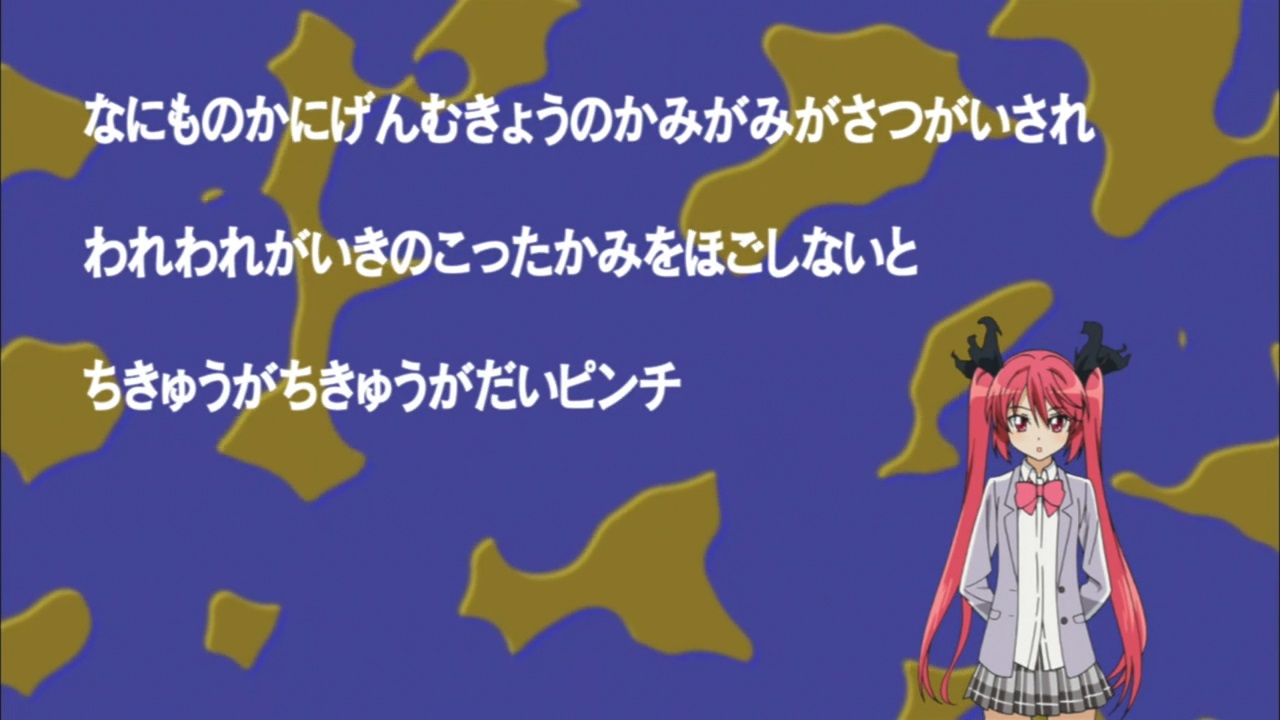
"The Earth, the earth, is in big trouble." (7:17)
The Japanese line is "Chikyuu ga chikyuu ga dai pinchi" (ちきゅうがちきゅうがだいピンチ). This is a line in the lyrics to "Faiyaaman" (ファイヤーマン), "Fireman", a song sung by Shimon Masato (子門真人) and released in 1973. This song is the opening theme song to "Fireman" (ファイヤーマン), a Japanese TV show about a costumed super hero that aired in 1973.S3 In addition, the background is also referencing to the opening sequence of this TV show. Images for reference:

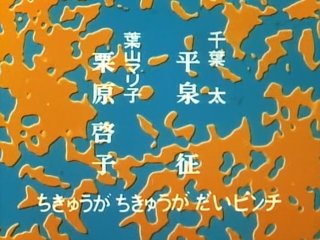
Source of images: http://nhh.mo-blog.jp/ttt/2010/08/post_bcc2.html
"We will use the boy's house as a base of operations." (7:41)
Cthuko addresses Mahiro as "shounen" (少年), which means "young boy". This is referencing Kamen Rider Hibiki from "Kamen Rider Hibiki" (仮面ライダー響鬼), a Japanese TV show about a masked super hero that aired from 2005 to 2006. In the series, Hibiki (ヒビキ) always addresses Adachi Asumu (安達明日夢) as "shounen" (少年).S6 It is not until the end of episode 39 that Hibiki finally calls Asumu by his actual name. On a related note, Cthuko and Hibiki are both able to use fire based attacks.S8
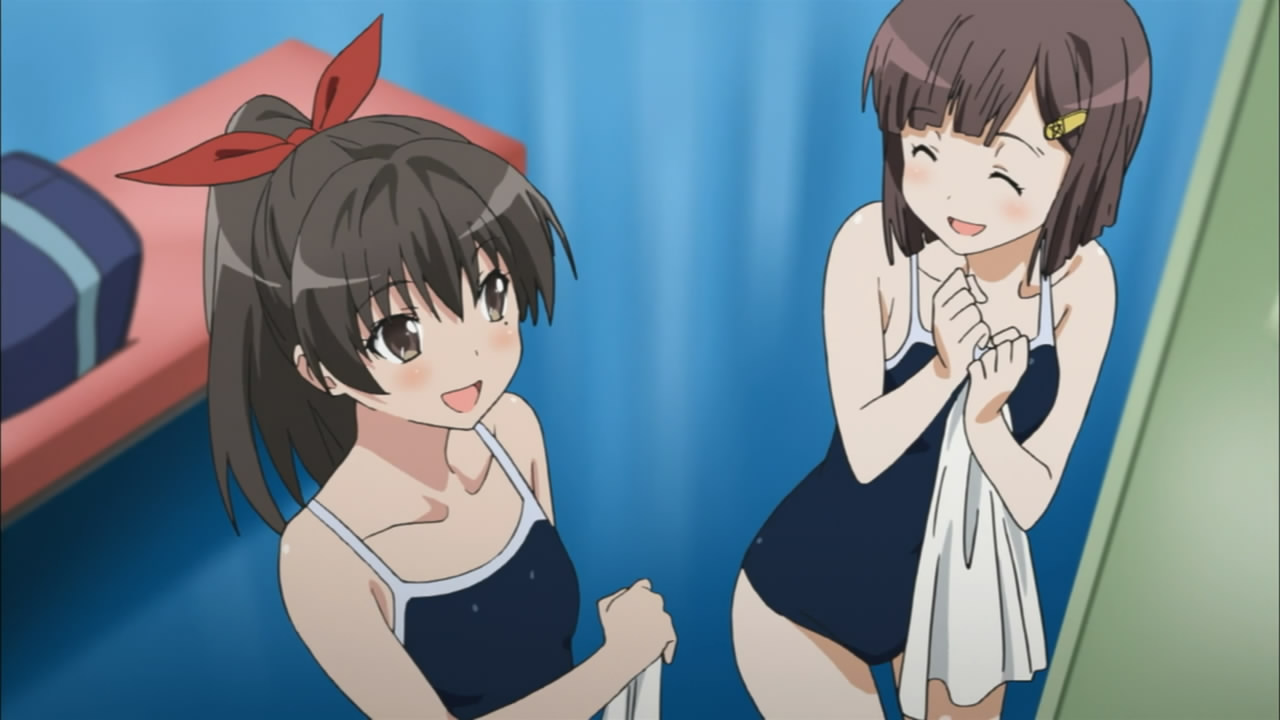
(8:58)
The appearances of the girls who appear in this scene are based on Higuchi Sayaka (樋口さやか) and Hino Mutsumi (日野睦) from "Ruruie Hai Sukuuru" (るるいえはいすくーる), "R'lyeh High School", an RPG replay book based on the "Call of Cthulhu" RPG that was written by Uchiyama Yasujirou (内山靖二郎), illustrated by Koin (狐印), and published in 2010.S7 On a related note, Koin also did the artwork for the "Haiyore! Nyaruko-san" light novel series. Here are Sayaka's and Mutsumi's character pages and the cover of "R'lyeh High School" for reference:


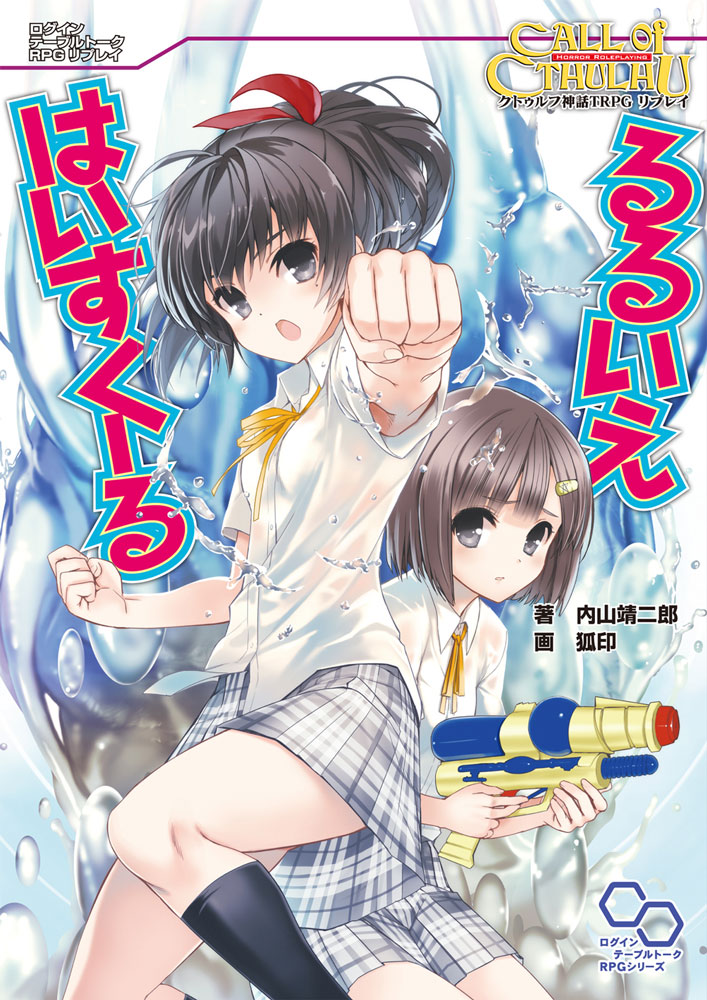
Source of images: https://bookwalker.jp/de0c6547d9-4bd2-4798-9c44-1236d4732353/
"Naragiri!" (11:33)
* As mentioned at 1:07, Naragiri (ナラギリ) is a creature that appears in "Shin Megami Tensei II" (真・女神転生II), "True Goddess Reincarnation 2".S1

(11:45)
There are two references here:
* The creature that appears behind Nyaruo, which is the form he transforms into later in the episode, is based on the Bloody Tongue, one of the many forms Nyarlathotep can assume in the Cthulhu Mythos. In the 5th edition rule book for the "Call of Cthulhu" RPG, it is described as follows:
"The Bloody Tongue is an enormous monster with clawed appendages and a single long blood-red tentacle in place of a face. This tentacle stretches forward when the Thing howls at the moon."* The depiction here of the Bloody Tongue is based on a depiction of the Bloody Tongue drawn by Nottsuo, which was used as the cover art of "CTHULHU 2010", a book containing supplemental material for the "Call of Cthulhu" RPG published by enterbrain (エンターブレイン) in 2010.S9 Image for reference:
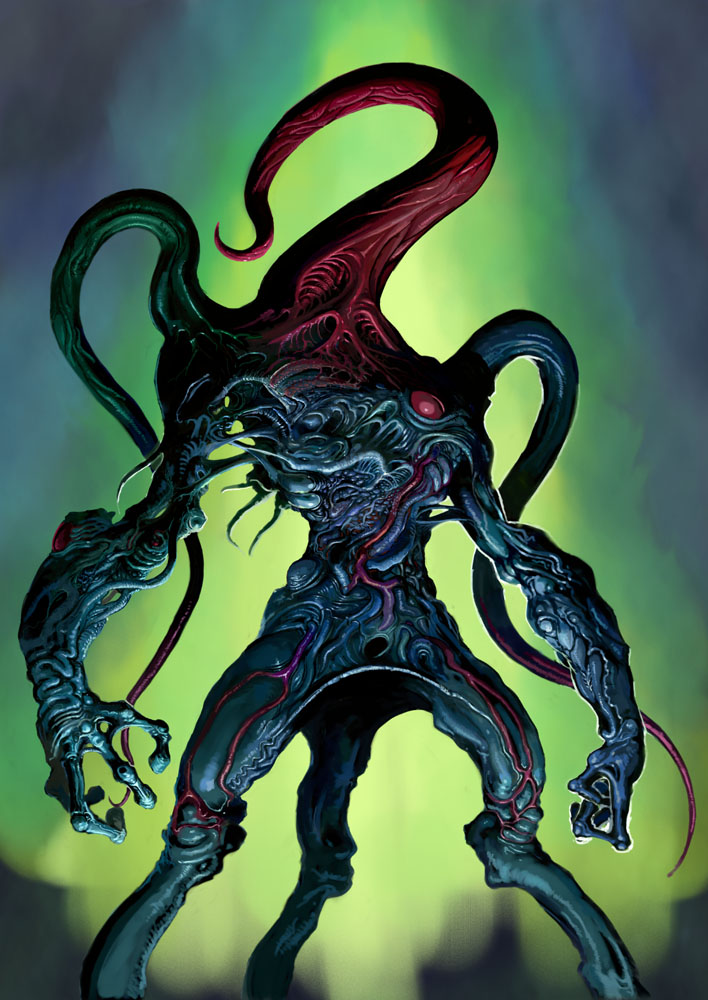
Source of image: https://www.pixiv.net/artworks/8756265
"Shantak laid a whole bunch this morning!" (12:10)
This is referencing how in "The Dream-Quest of Unknown Kadath", a story written by H. P. Lovecraft and published in 1943, Shantak are said to lay "colossal and rich-flavoured eggs".S9
"If they have no bread, let them eat cake." (12:43)
This is referencing a mistranslation of a the French phrase "Qu'ils mangent de la brioche", which means "Let them eat brioche". Brioche is an expensive type of bread that contains a high amount of egg and butter. This quote appears in Jean-Jacques Rousseau's autobiography, "Les Confessions". Rousseau writes,
"Enfin je me rappelai le pis-aller d'une grande princesse à qui l'on disait que les paysans n'avaient pas de pain, et qui répondit: Qu'ils mangent de la brioche."S10This quote is often misattributed to Marie Antoinette. It is generally used to express the insensitivity or disdain of the upper classes towards the conditions and problems of the lower classes.
"At length I remembered the last resort of a great princess who, when told that the peasants had no bread, replied: 'Then let them eat brioches.'"S11
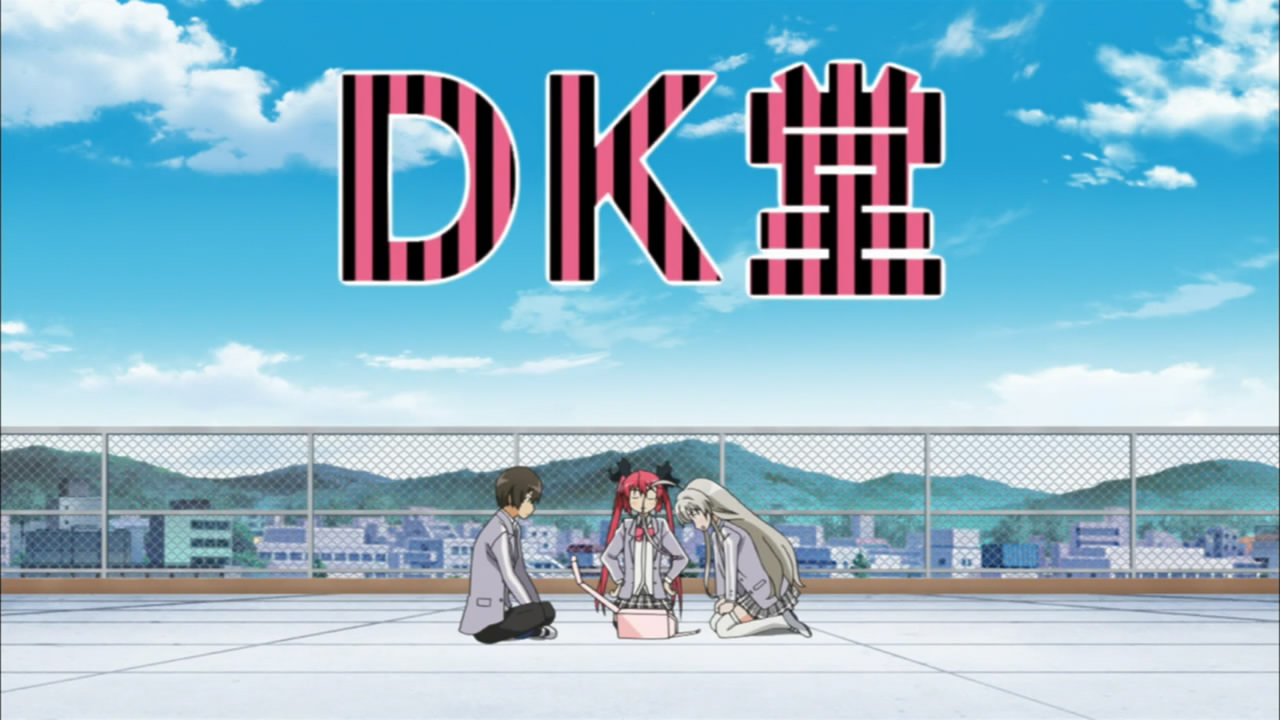

"DK-do" (12:55)
"D. Endou" (13:02)
"DK-do" (DK堂), "DK Bakery", is pronounced as "Dee-Kay-Doh". "D. Endou" (D・遠藤) is pronounced as "Dee-End-Oh". These are both puns of "Dikeido" (ディケイド), "Decade", and "Diendo" (ディエンド), "Diend", the names of two characters from "Kamen Rider Decade" (仮面ライダーディケイド), a Japanese TV show about a masked super hero that aired in 2009. The color schemes of "DK-do" and "D. Endo" also match that of Decade and Diend.S2 Images for reference:
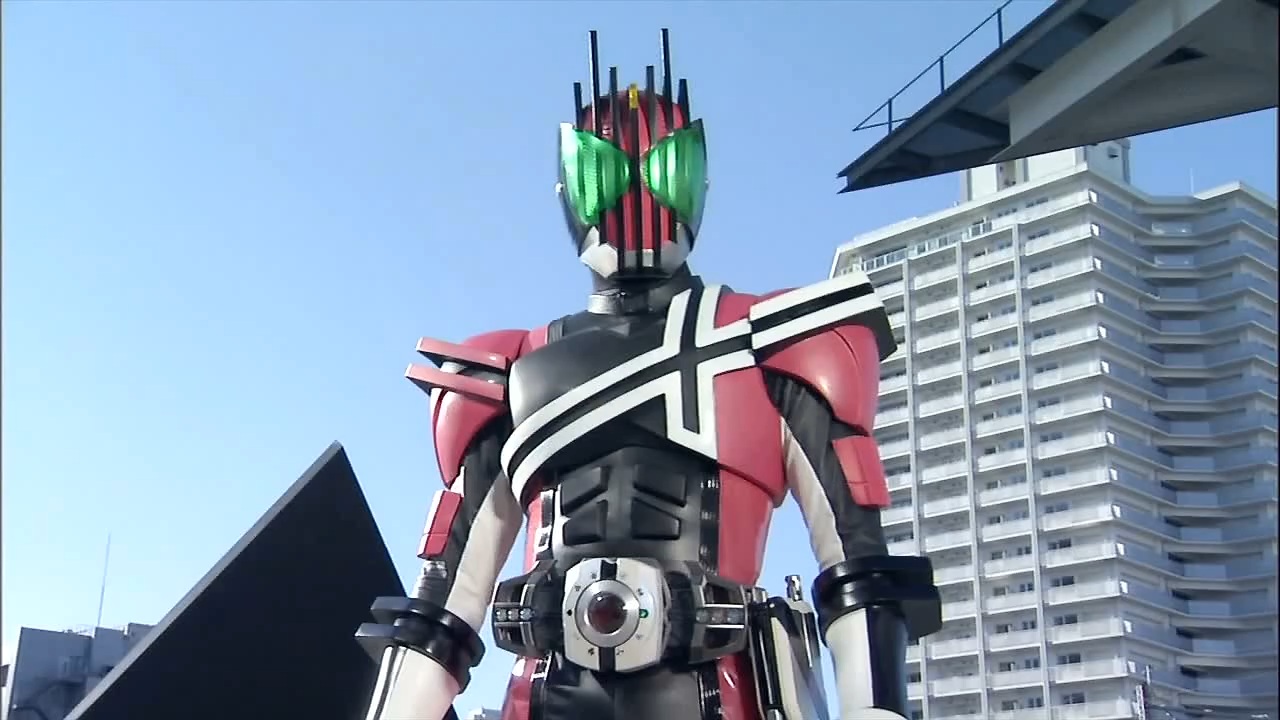
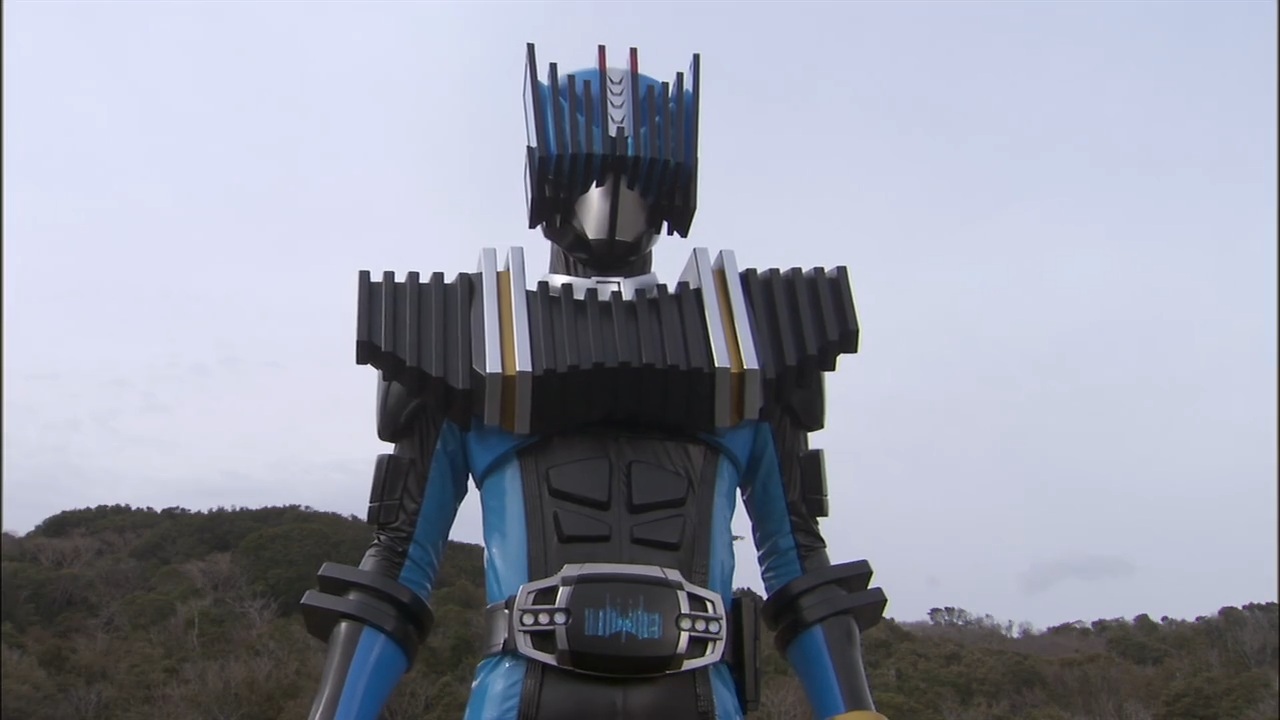
"While I was working as a home security guard, I met a guy in cyberspace who worked at the bakery." (13:07)
The term "jitaku keibiin" (自宅警備員), "home security guard", is an internet slang term that is used to describe people who stay at home all the time. They are sarcastically described as defending their homes like a security guard would.S6
"You mean while you played online games when you were a NEET." (13:13)
"NEET" is an acronym that stands for "Not in Education, Employment, or Training" and refers to a person who is unemployed and not receiving an education or vocational training. Though it originated in the United Kingdom, it is also often used in Japan.

(13:22)
The design of the cake is based on the Decadriver (ディケイドライバー), Kamen Rider Decade's transformation belt in "Kamen Rider Decade" (仮面ライダーディケイド).S2 Image for reference:
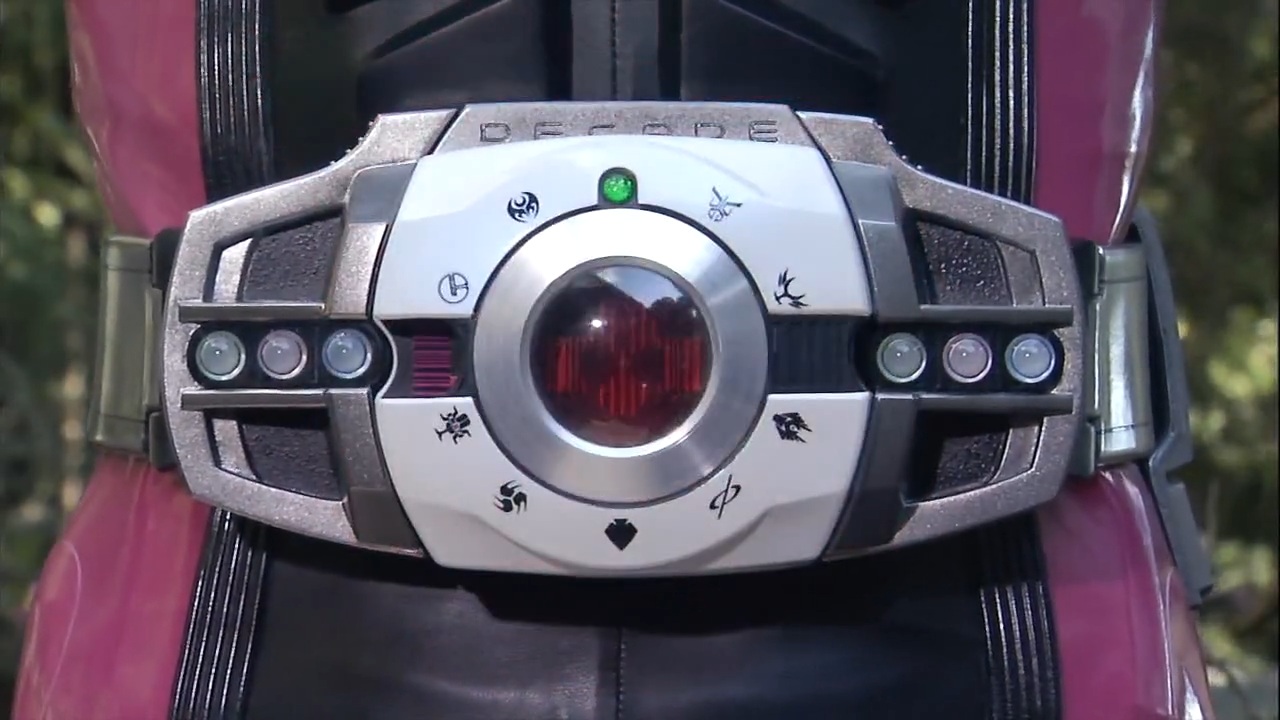
(13:45)
The line at this time goes as follows:
「人は何かの代償なしに、何かを得ることは出来ない。これが等価交換の原則。」This is referencing a line said by Alphonse Elric (アルフォンス・エルリック) in episode 2 of "Hagane no Renkinjutsushi" (鋼の錬金術師), "Fullmetal Alchemist", an anime series that aired from 2003 to 2004. The original line goes as follows:
"Hito ha nanika no daishou nashi ni, nanika wo eru koto ha dekinai. Kore ga touka koukan no gensoku."
"Humankind cannot gain anything without first giving something in return. This is the fundamental rule of equivalent exchange."
「人は何かの犠牲なしに何も得ることはできない。何かを得るためには同等の代価が必要となる。それが錬金術における等価交換の原則だ。」
"Hito ha nanika no gisei nashi ni nani mo eru koto ha dekinai. Nanika wo eru tame ni ha doutou no daika ga hitsuyou to naru. Sore ga renkinjutsu ni okeru touka koukan no gensoku da."
"Humankind cannot gain anything without first giving something in return. To obtain, something of equal value must be lost. In alchemy, that is the fundamental rule of equivalent exchange."
"Hold it!" (13:36)
The Japanese line is "Chotto matta!" (ちょっと待った!). This is referencing the same line from the Japanese dating show "Neruton Benikujira Dan" (ねるとん紅鯨団). In the show there are several male and female participants and during the show they all get to know each other. At the end of the show is a segment called "Kokuhaku Taimu" (告白タイム), "Confession Time", during which the male and female participants line up opposite each other and, one by one, each guy will confess to the woman he likes. When one guy is confessing, another guy may call out "Chotto matta!" (ちょっと待った!), "Hold it!", and confess as well.S7

(13:53)
The Japanese line is "Gununu" (ぐぬぬ). Nyaruko's line and facial expression are referencing Ana Coppola (アナ・コッポラ) from "Ichigo Mashimaro" (苺ましまろ), "Strawberry Marshmallow", a manga series written by Barasui (ばらスィー) and published starting from 2001. An anime adaptation of the series aired in 2005. In episode 2 of this anime series, Ana says the same line and makes the same facial expression.S6 Image for reference:

"The Dreamland is the land of dreams." (14:59)
This is referencing the Dreamland, a fictional location in the Cthulhu Mythos that humans can enter when they fall asleep.S3
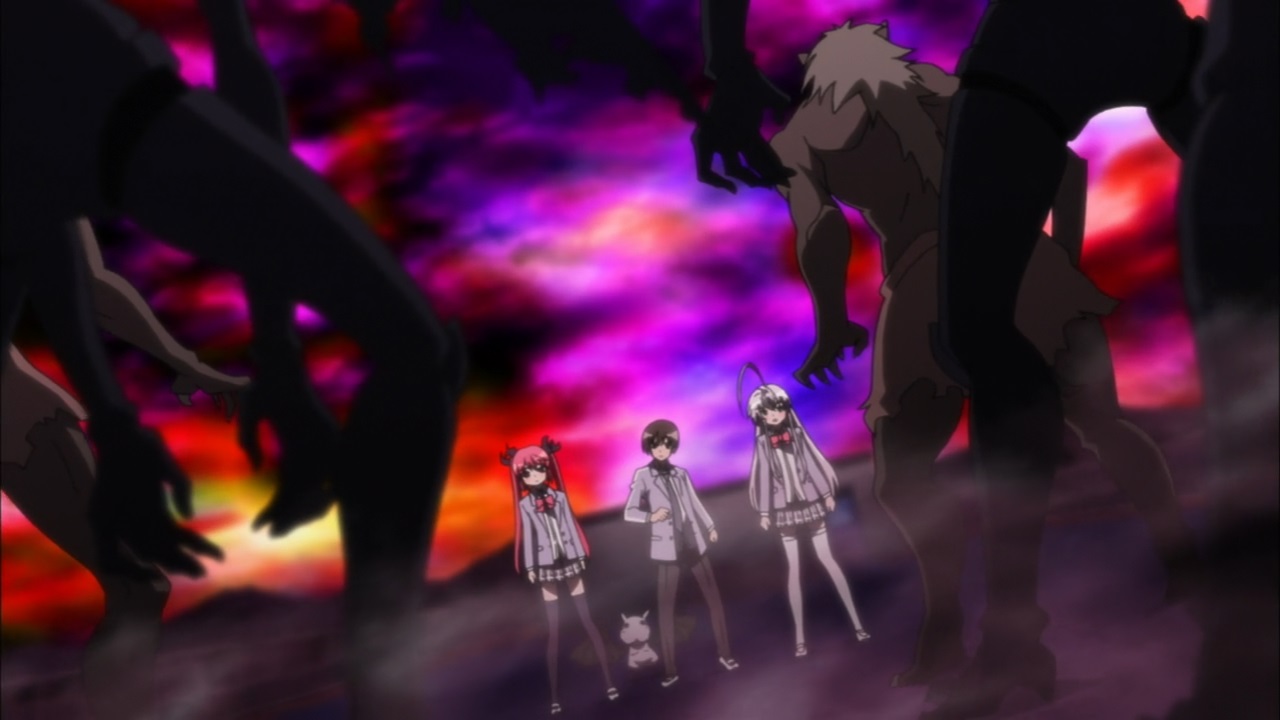
(15:18)
Nightgaunts return in this episode. Ghouls are another species of creature in the Cthulhu Mythos. In "Pickman's Model", a short story written by H. P. Lovecraft and first published in 1927, they are described as follows:
"These figures were seldom completely human, but often approached humanity in varying degree. Most of the bodies, while roughly bipedal, had a forward slumping, and a vaguely canine cast. The texture of the majority was a kind of unpleasant rubberiness."
"Anti-ship chainsaw not to be described!" (15:42)
The Japanese line is "Kuchi ni suru no mo habakarareru taikan cheensoo!" (口にするのもはばかられる対艦チェーンソー!). There are five references here:
* The phrase "kuchi ni suru no mo habakarareru" (口にするのもはばかられる), "not to be described", is referencing a character referred to as "the high-priest not to be described" that appears in "The Dream-Quest of Unknown Kadath", a story written by H. P. Lovecraft and first published in 1943.S9 The true identity of the high-priest is not revealed in the story. However, when the protagonist of the story encounters the high-priest, he realizes the high-priest's true identity and flees in great fear. It is possible the high-priest is an avatar of Nyarlathotep.
* "Taikan" (対艦), "anti-ship", is referencing "taikantou" (対艦刀), "anti-ship sword", a weapon that appears in "Mobile Suit Gundam SEED" (機動戦士ガンダムSEED), an anime series that aired from 2002 to 2003.S6
* As a whole, "taikan cheensoo" (対艦チェーンソー), "anti-ship chainsaw", is referencing "taisensha cheensoo" (対戦車チェーンソー), "anti-tank chainsaw", a weapon used by Bargain Ales (バルガイン・エイルス) in "WILD ARMS the 4th Detonator" (ワイルドアームズ ザ フォースデトネイター), a video game released by Media.Vision (メディア・ビジョン) in 2005. Image for reference:
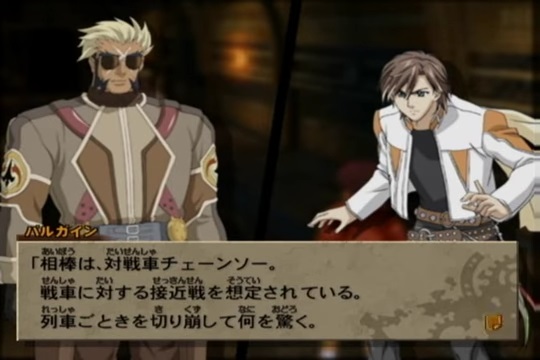
Source of image: https://www.youtube.com/watch?v=Gz-tmmlvrbI
* The chainsaw is another weapon that has appeared in "Call of Cthulhu" role playing games as far back as the 5th edition, published in 1992. Weapons Table from the "Call of Cthulhu" 5th edition rulebook for reference.
* The anti-ship chainsaw also appeared in the "Haiyore! Nyaruko-san" light novel series. It is referencing "Makai Toushi SaGa" (魔界塔士Sa・Ga), "Demon World Tower Warrior SaGa", a game released by Square (スクウェア) in 1989.S1 Some spoilers to follow from here. On page 48 of volume 2 of the light novel series, when asked what the chainsaw is Nyaruko replies as follows:
「太古の昔です。地球の神様がすんげー暇を持て余した挙げ句、自らが創造した人間を使って一つのゲームを思いついたんです。地上から天まで届く塔を築き 上げ、道中に魔物を配置して人間達に天を目指させる。ちっぽけな人間が必死に生きる姿は神様すら感動させるものがあったそうです。しかし天に辿り着いた唯 一の集団は、そんな自分勝手な神様に反旗を翻したんですよ。人間対神様の戦いは熾烈を極めました。光あったり悔い改めたり。しかし、その際に神様への切り 札になった武器がこのチェーンソーだったという話です。あわれ、神様は正中線からまっぷたつ。人間は神様の束縛から解き放たれて真なる自由を得る事に」This is a rough summary of the plot of "Makai Toushi SaGa". Also, there is a weapon in the game called "cheensoo" (チェーンソー), "chainsaw", that is able to defeat the final boss in one hit. The chainsaw was intended to be able to instantly defeat a target if the user's strength stat is higher than the target's defense stat. However, due to a programming mistake, instead it is able to instantly defeat a target if the user's strength stat is lower than the target's defense stat. As a result, the final boss, which has a very high defense stat, is susceptible to this weapon.
"It is ancient times. The god of Earth finally found his extreme boredom unbearable. Using the humans he created, he thought up a game. He built a tower reaching from the ground to the heavens. He deployed demons throughout the tower and had the humans aim for the heavens. It seemed the sight of the tiny humans desperately clinging to life was something that even god was moved by. However, the sole group that finally reached heaven revolted against the selfish god. Man's fight against god was extremely fierce. There was light. There was repentance. However, this is the story of how on that occasion the weapon that became the trump card against god was this chainsaw. Alas, god was split in two down the center. Man was released from god's bindings and obtained true freedom"
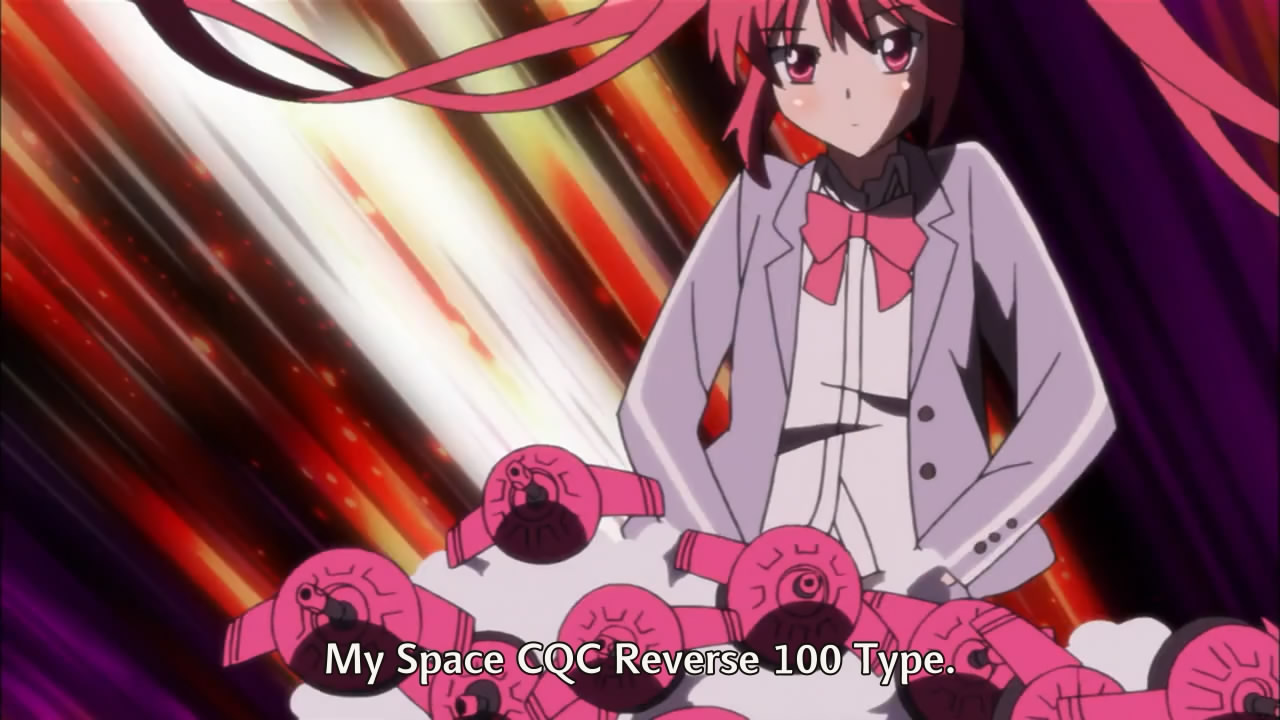
(15:46)
Cthuko releasing weapons from under her skirt is referencing Mech-Hisui (メカヒスイ) from "Melty Blood" (メルティブラッド), a series of video games that began release in 2002. In the series, Mech-Hisui is able to release a small missile from under her dress. On a related note, Cthuko's voice actor, Matsuki Miyu (松来未祐), also voices Mech-Hisui.S7 Video for reference: https://youtu.be/7adaWuai3QQ?t=160
"Tezcatlipoca!" (16:12)
There are three references here:
* As mentioned at 1:07, Tezcatlipoca (テスカトリポカ) is a creature that appears in "Shin Megami Tensei II" (真・女神転生II), "True Goddess Reincarnation 2".S1
* In the Cthulhu Mythos, Tezcatlipoca is an avatar of Nyarlathotep.S9 It appears in "A Resection of Time", a book containing supplemental material for the "Call of Cthulhu" RPG published by Chaosium in 1997.
* Tezcatlipoca appears as an avatar of Nyarlathotep in "LIBROS DE CHILAM BALAM" (ティラムバラム), "Books of Chilam Balam", a video game released by RIGHT STUFF (ライトスタッフ) in 1992.S9
"Once again I have cut a worthless object." (16:21)
The Japanese line is "Mata tsumaranu mono wo kitte shimatta" (またつまらぬ物を斬ってしまった). This is the catch phrase of Ishikawa Goemon (石川五エ門) in "Lupin III" (ルパン三世), a manga series written by Monkey Punch (モンキー・パンチ) and published from 1967 to 1969. Goemon will say this line after he uses his sword, Zantetsuken (斬鉄剣), to cut something.
Background music (16:48)
The song that plays at this time is referencing "Taboo" (タブー), a Cuban song originally composed by Margarita Lecuona in the 1930's. The song is famous in Japan due to the use of a cover of it in a series of comedy routines performed by Japanese comedian Katou Cha (加藤茶) of "The Drifters" (ザ・ドリフターズ), a Japanese comedy group. During such a routine, Katou will pretend to strip while "Taboo" plays in the background, and he will say the lines "Chotto dake yo" (ちょっとだけよ), "Just a little bit", and "Anta mo suki nee" (あんたも好きねえ), "You like that too, eh?".S4 The connection is made clear by "Jashin Kyoku Tachi" (邪神曲たち), "Evil God Song Collection", a set of music discs containing songs sung by the cast of "Haiyore! Nyaruko-san" and the original soundtrack for the series released in 2012. The song is track 28 on disc 2, and the title of the song is "Chotto dake yoo" (ちょっとだけよぉ), which is referencing the gag phrase that Katou says in the routines.
"What... the hell...?" (17:07)
The Japanese line is "Nan... da to...?" (なん・・・だと・・・?). This is likely referencing "BLEACH" (ブリーチ), a manga series written by Kubo Tite (久保帯人) and published from 2001 and is currently ongoing. In the series, this phrase and variations of it are often used.S3 Image for reference:


(18:00)
The test papers bear great resemblance to a page in "Al Azif: The Necronomicon", a book published in 1973 that is based on the Necronomicon from the Cthulhu Mythos.S5 Image for reference:
Source of image: http://f.hatena.ne.jp/servitors/20120426225249
"No, today there's a preview of the new Iron Striver series, 'Trapezohedron is Unbreakable!'" (18:27)
There are two references here:
* "Torapezohedoron ha Kudakenai" (トラペゾヘドロンは砕けない), "Trapezohedron is Unbreakable", is referencing "Jojo no Kimyou na Bouken" (ジョジョの奇妙な冒険), "Jojo's Bizarre Adventure", a manga series written by Araki Hirohiko (荒木飛呂彦) and published starting from 1987. The title of the fourth story arc of this series is "Daiyamondo ha Kudakenai" (ダイヤモンドは砕けない), which translates to "Diamond is Unbreakable".
* This is referencing the Shining Trapezohedron from "The Haunter of the Dark", a story written by H. P. Lovecraft and first published in 1936. The Shining Trapezohedron is a mystical crystal that is described as being "a window on all time and space" and is capable of summoning the Haunter of the Dark, an avatar of Nyarlathotep.
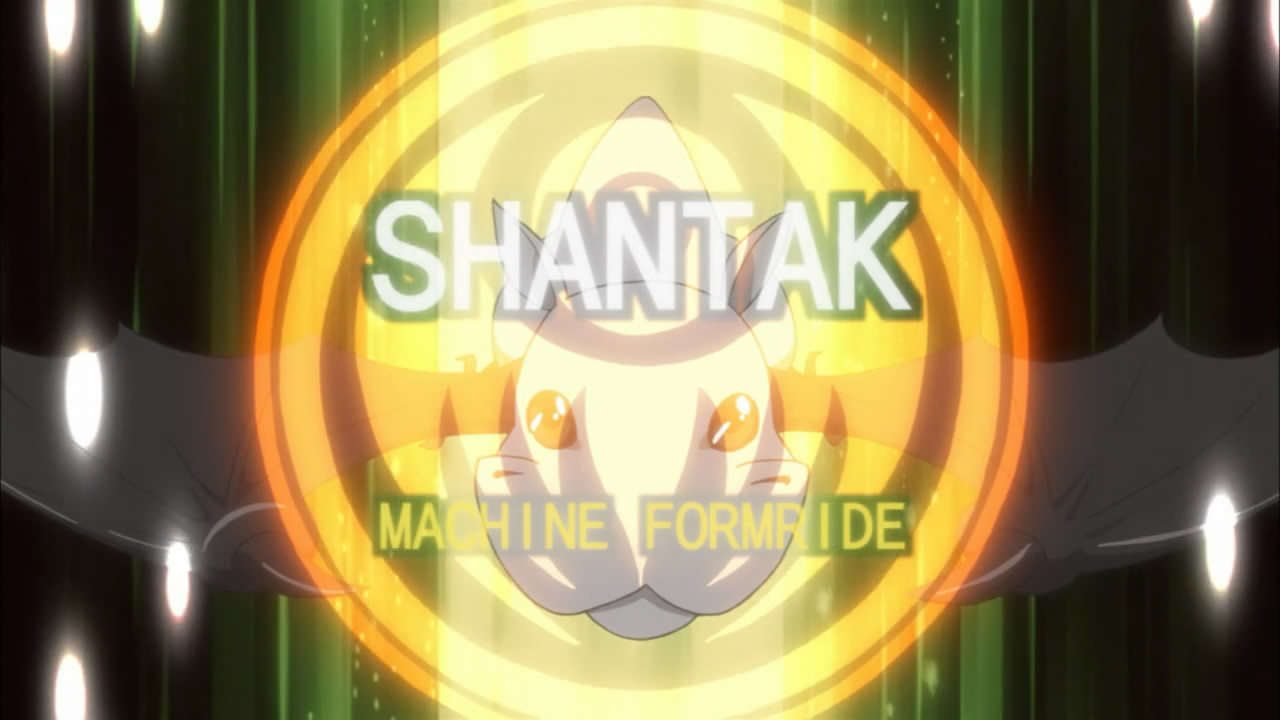
"This will tickle a little. Don't worry, the pain only lasts an instant." (18:47)
"SHANTAK MACHINE FORMRIDE" (18:54)
The "MACHINE FORMRIDE" transformation is referencing Kamen Rider Decade and Kamen Rider Diend from "Kamen Rider Decade" (仮面ライダーディケイド). Both characters can use an ability called "FINAL FORMRIDE" that allows them to transform their allies into alternate forms, such as tools or weapons.S2 The "MACHINE FORMRIDE" symbol is based on the logo for "Kamen Rider Kiva" (仮面ライダーキバ), a Japanese TV show about a masked super hero that aired from 2008 to 2009.S3 Image for reference:
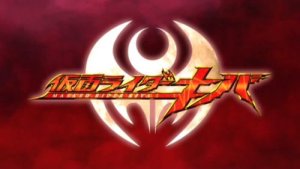
Source of image: https://en.wikipedia.org/wiki/File:KR_Kiva_Title_Card.jpg
This same symbol is used when the "FINAL FORMRIDE" ability is used in conjunction with Kamen Rider Kiva. Image for reference:

Nyaruko's line consists of two parts. The first part is "Chotto kusuguttai desu yo" (ちょっとくすぐったいですよ), "This will tickle a little", which is referencing what Decade says when he uses "FINAL FORMRIDE". Decade's line goes, "Chotto kusuguttai zo" (ちょっとくすぐったいぞ), which has the same meaning. The second part is "Nani, itami ha isshun desu" (なに、痛みは一瞬です), "Don't worry, the pain only lasts an instant", which is referencing what Diend says when he uses "FINAL FORMRIDE". Diend's line goes, "Itami ha isshun da" (痛みは一瞬だ), which translates to "The pain only lasts an instant".S1

(19:00)
This scene is referencing Riderman (ライダーマン) from "Kamen Rider V3" (仮面ライダーV3), a Japanese TV show about a masked super hero that aired from 1973 to 1974.S2 In the series, Riderman transforms by equipping his helmet. The bright background is also referencing that from Riderman's transformation sequence. Images for reference:

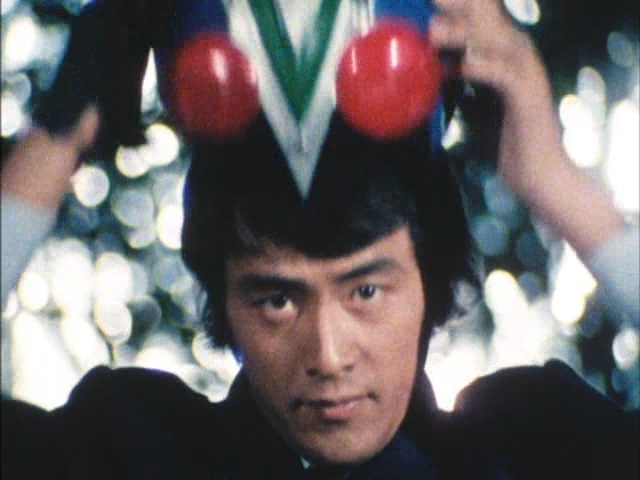

"Also known as the Machine Shantacar!" (19:02)
There are two references here:
* "Mashin Shantakkaa" (マシンシャンタッカー), "Machine Shantacar", is referencing "Mashin Dikeidaa" (マシンディケイダー), "Machine Decader", Kamen Rider Decade's motorcycle in "Kamen Rider Decade" (仮面ライダーディケイド).S6
* The use of Shanta as a bike is referencing how in "The Dream-Quest of Unknown Kadath", a story written by H. P. Lovecraft and published in 1943, Shantaks are used for transportation.S9
"Nyaruko, heading out!" (19:10)
The Japanese line is "Nyaruko, ikkimasu!" (ニャル子、いっきます!). This is referencing the catch phrase of Amuro Ray (アムロ・レイ) in "Mobile Suit Gundam" (機動戦士ガンダム), an anime series that aired from 1979 to 1980.S3 His original line goes, "Amuro, ikimasu!" (アムロ、行きます!), which translates to "Amuro, heading out!". Video for reference: https://youtube.com/watch?v=hwTcoSPPdqo
"There's no such thing as a younger sister who surpasses her older brother!" (19:19)
The Japanese line is "Ani yori sugureta imouto nazo sonzai shinee!" (兄よりすぐれた妹なぞ存在しねえ!). This is referencing a line said by Jagi (ジャギ) in chapter 40 of volume 5 of "Hokuto no Ken" (北斗の拳), "Fist of the North Star", a manga series written by Buronson (武論尊) and published from 1983 to 1988. His original line goes "Ani yori sugureta otouto nazo sonzai shinee!" (兄よりすぐれた弟なぞ存在しねえ!), which translates to "There's no such thing as a younger brother who surpasses his older brother!".S3 Image for reference:
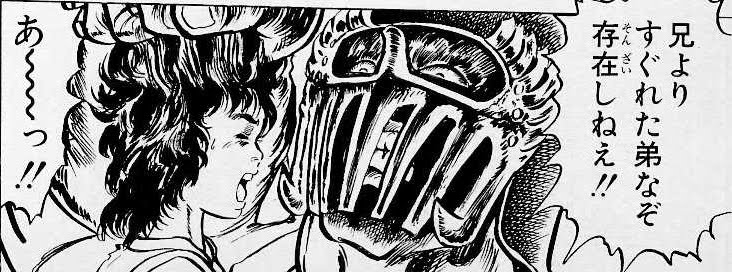
"I will transcend Nyarlathotep!" (19:25)
The Japanese line is "Watashi ha nyaruratohotepu wo chouetsu suru!" (私はニャルラトホテプを超越する!). This is referencing a line said by Dio Brando (ディオ・ブランドー) in chapter 11 in volume 2 of "Jojo no Kimyou na Bouken" (ジョジョの奇妙な冒険), "Jojo's Bizarre Adventure", a manga series written by Araki Hirohiko (荒木飛呂彦) and published starting from 1987. His line goes, "Ore ha ningen wo chouetsu suru!" (おれは人間を超越するッ!), which translates to "I will transcend humans!". Image for reference:
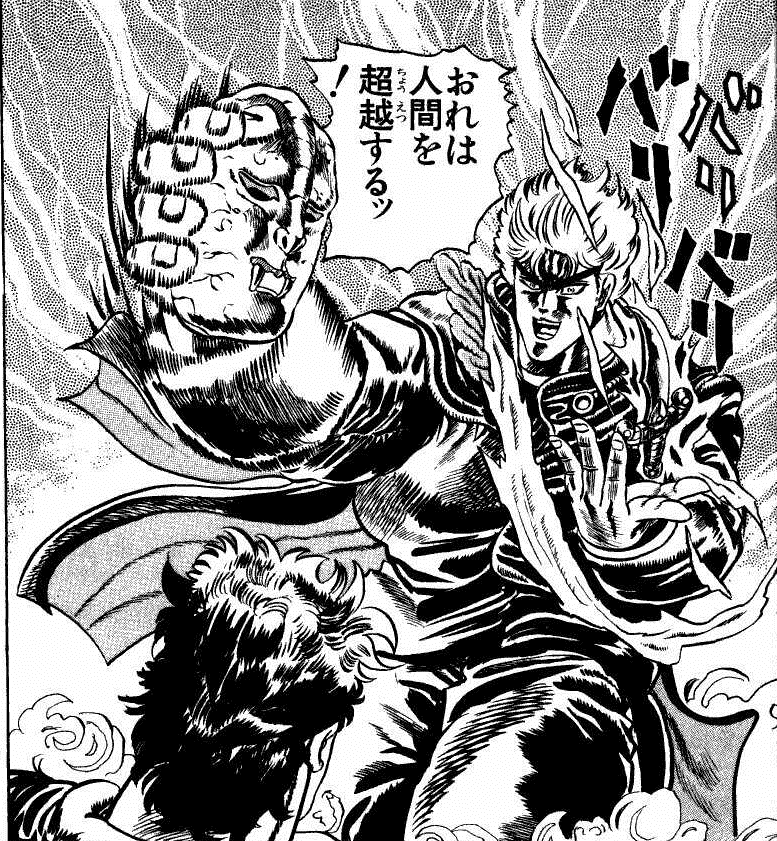
(19:28)
A this time Nyaruo repeatedly says, "Muda" (無駄), which translates to "useless" or "futile". This is a repeat of a reference in episode 2 at 16:25. This is referencing the same line often said by Dio Brando (ディオ・ブランドー) in "Jojo no Kimyou na Bouken" (ジョジョの奇妙な冒険), "Jojo's Bizarre Adventure". Image for reference:
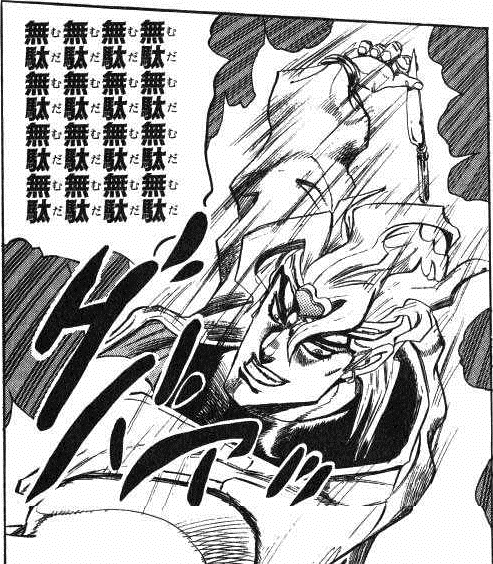
(19:49)
The line at this time goes as follows:
「真尋さんは今まで食べたパンの枚数を覚えていますか?」This is referencing lines said by William Anthonio Zeppeli (ウィル・A・ツェペリ) and Dio Brando (ディオ・ブランドー) in chapter 25 in volume 3 of "Jojo no Kimyou na Bouken" (ジョジョの奇妙な冒険), "Jojo's Bizarre Adventure".S3 The original lines go as follows:
"Mahiro-san ha ima made tabeta pan no maisuu wo oboeteimasu ka?"
"Mahiro, do you remember how many loaves of bread you've eaten up until now?"
ツェペリ: 「きさま—いったい何人の生命をその傷のために吸い取った!?」Image for reference:
ディオ: 「おまえは今まで食ったパンの枚数をおぼえているのか?」
Zeperi: "Kisama—ittai nannin no inochi wo sono kizu no tame ni suitotta!?"
Dio: "Omae ha ima made tabeta pan no maisuu wo oboeteiru no ka?"
Zeppeli: "You fiend—Just how many lives have you sucked up for the sake of healing that wound!?"
Dio: "Do you remember how many loaves of bread you've eaten up until now?"
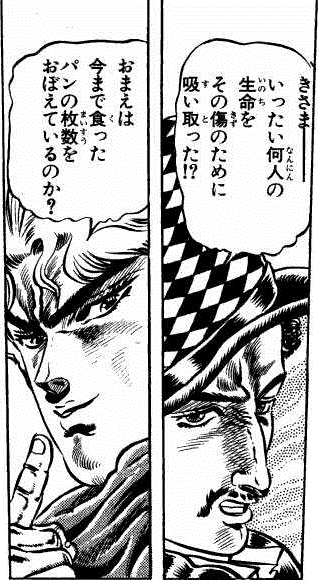

(19:59)
The game device Cthuko is playing with is based on the PlayStation Portable (プレイステーション・ポータブル), a handheld video game console released by Sony (ソニー) in 2004. Image for reference:

Source of image: https://en.wikipedia.org/wiki/File:Sony-PSP-1000-Body.png
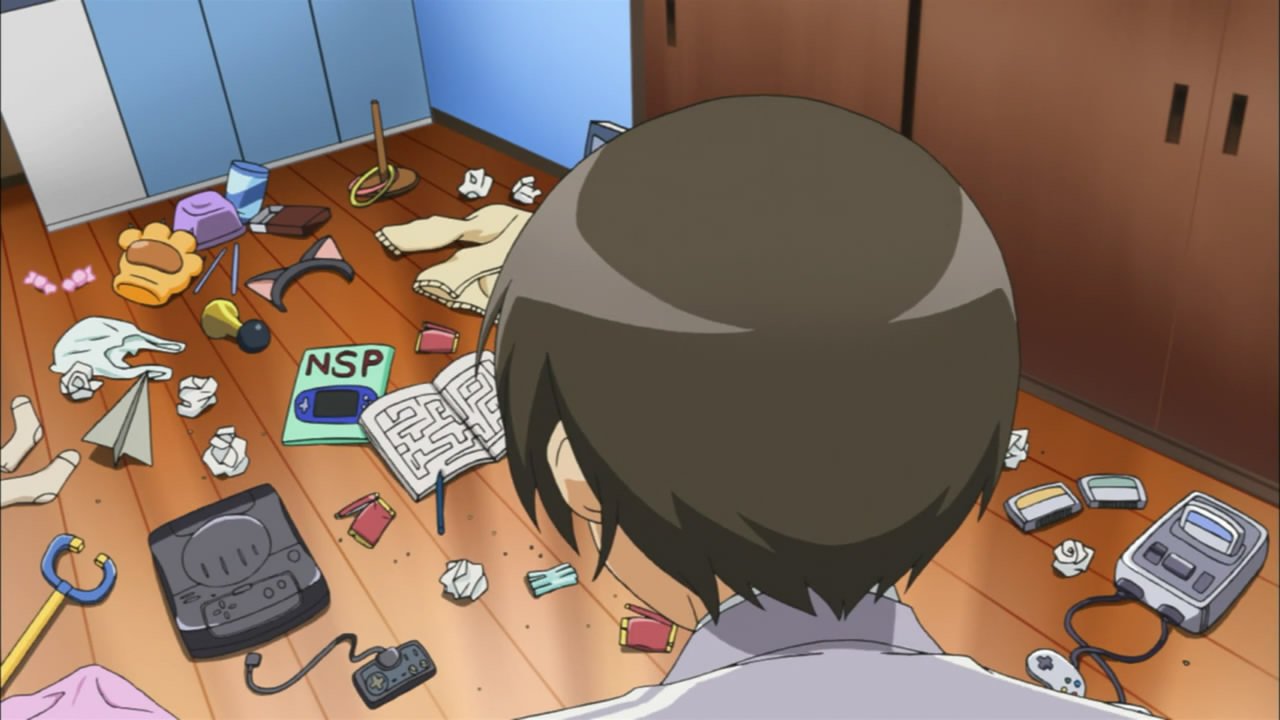
(20:07)
There are four references here:
* There is a device that is based on the Playdia (プレイディア), a video game console released by Bandai (バンダイ) in 1994.S1 Image for reference:
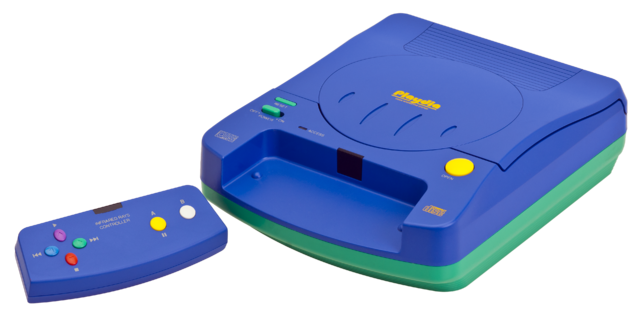
Source of image: https://en.wikipedia.org/wiki/File:Playdia-Console-Set.png
* There is a device that is based on the controller for the PC Engine (PCエンジン), also known as the TurboGrafx-16, a video game console released by Hudson (ハドソン) in 1987.S1 Image for reference:
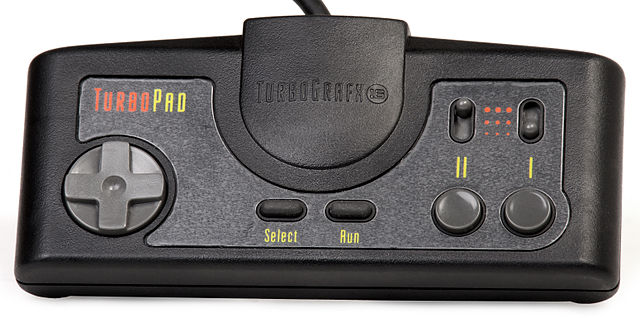
Source of image: https://en.wikipedia.org/wiki/File:TurboGrafx-16-Controller.jpg
* There is a magazine with a picture of a PlayStation Portable, with the abbreviation NSP instead of PSP.S1
* There is a device that is based on the Super Famicom (スーパーファミコン), also known as the Super Nintendo Entertainment System, a video game console released by Nintendo (任天堂) in 1990. Some game cartridges for the system can also be seen.S1
Image for reference:
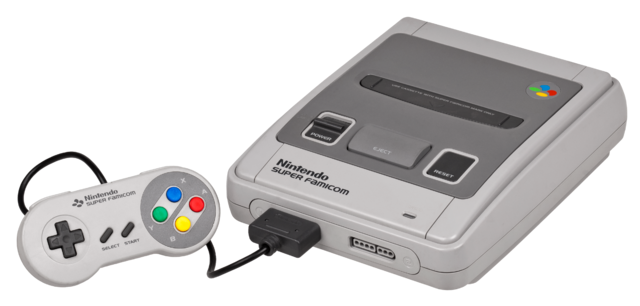
Source of Image: https://en.wikipedia.org/wiki/File:Super-Famicom-Console-Set.png
"Yes, this is the lovely Nyaruko." (20:10)
"Raburii Nyaruko" (ラブリーニャル子), "Lovely Nyaruko", is referencing "Dirty Pair" (ダーティペア), a light novel series written by Takachiho Haruka (高千穂遙) and published starting from 1979.S3 In the series, the code name for the protagonists is "Raburii Enzeru" (ラブリーエンゼル), "Lovely Angels".
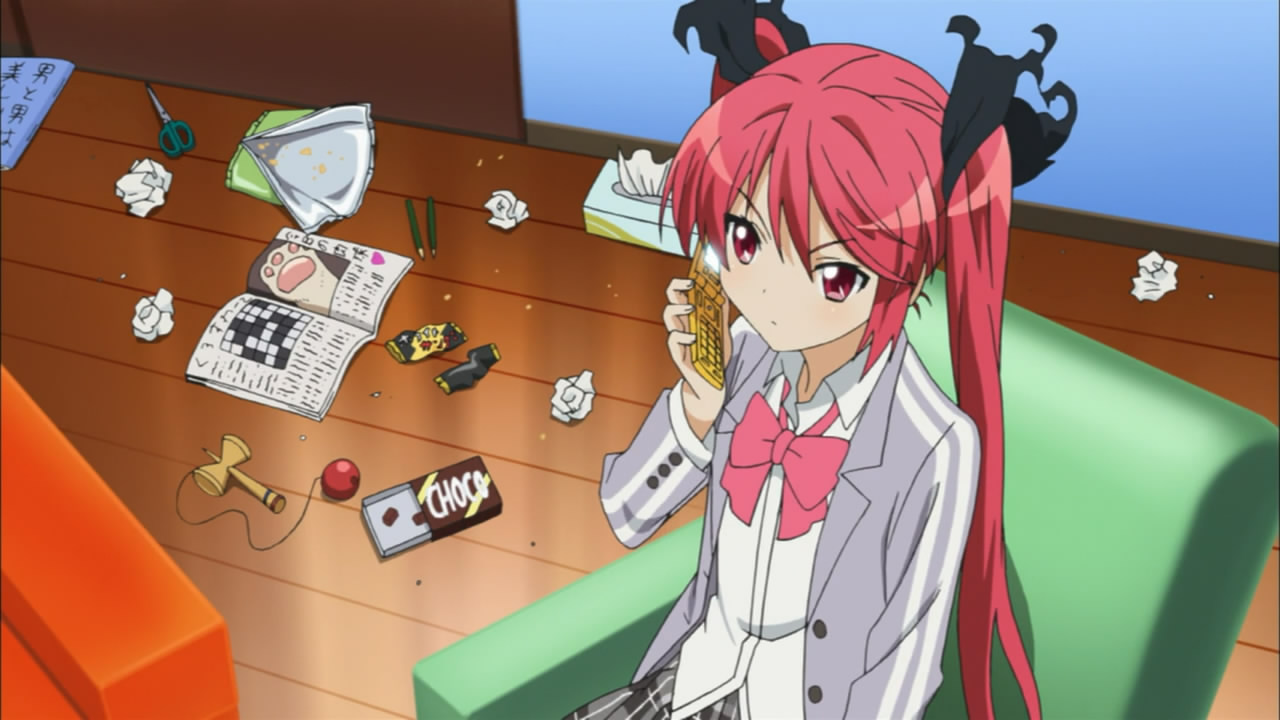
(20:27)
There are two references here:
* Next to the open book is a candy wrapper that has the text 「ホワイトサンダー」 written on it. The text reads "Howaito Sandaa", "White Thunder". This is referencing "Burakku Sandaa" (ブラックサンダー), "Black Thunder", a chocolate bar made and sold in Japan by the Yuraku Confectionery Company (有楽製菓株式会社).S7 Image for reference:
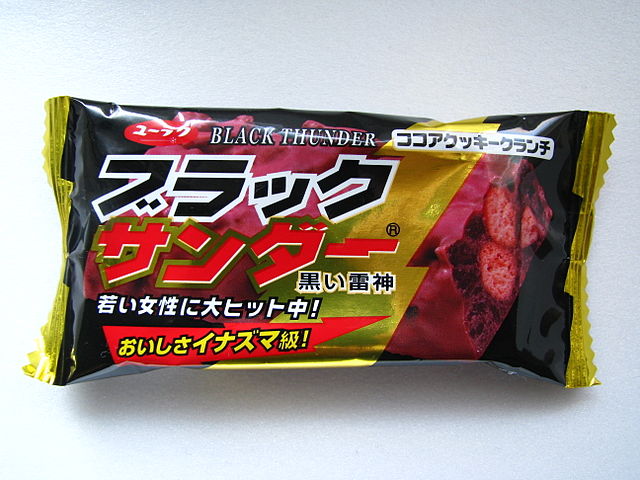
Source of Image: https://en.wikipedia.org/wiki/File:Black_Thunder.JPG
* This is referencing "Futari ha Purikyua" (ふたりはプリキュア), "We are Pretty Cure", an anime series that aired from 2004 to 2005.S7 In the series, "Black Thunder" (ブラックサンダー) and "White Thunder" (ホワイトサンダー) are phrases chanted by Cure Black (キュアブラック) and Cure White (キュアホワイト) when they use "Pretty Cure Marble Screw" (プリキュア・マーブル・スクリュー), one of their special attacks.
"I've been transferred to the team assisting the gods of Dreamland." (20:51)
In the Cthulhu Mythos, Nyarlathotep is the protector of the Great Ones, the gods of Earth's Dreamland.S1 In "The Dream-Quest of Unknown Kadath", a story written by H. P. Lovecraft and first published in 1943, it is stated that the Great Ones are "subject to strange protection from the mindless Other Gods from Outside, whose soul and messenger is the crawling chaos Nyarlathotep."

(21:03)
There is a device that is based on the Game Boy Color (ゲームボーイカラー), a handheld video game console released by Nintendo (任天堂) in 1998. Game cartridges for the Game Boy can also be seen. Image for reference:

Source of image: http://www.giantbomb.com/game-boy-color/60-57/
"I'll be home in 40 seconds." (22:02)
The Japanese line is "Yonjuu byou de kaeru kara ne" (40秒で帰るからね). This is referencing a line said by Dola (ドーラ) in "Tenkuu no Shiro Rapyuta" (天空の城ラピュタ), "Laputa: Castle in the Sky", a movie released in 1986.S3 The original line is, "Yonjuu byou de shitaku shi na!" (40秒で支度しな!), which translates to "Get ready in 40 seconds!".
"Well then, the next episode of 'Crawl! Nyaruko' is..." (23:49)
The Japanese line is "Saate, jikai no Haiyore! Nyaruko-san ha" (さぁて、次回の這いよれ!ニャル子さんは). This is referencing the next episode preview for the anime adaptation of "Sazae-san" (サザエさん), originally a manga series written by Hasegawa Machiko (長谷川町子) and published from 1946 to 1974. It was adapted into an anime series in 1969 and is currently ongoing. The original line is "Saate, jikai no Sazae-san ha?" (さ~て、次回のサザエさんは?), which translates to "Well then, the next episode of Sazae-san is?".S3
"'Mothers Attack!' Change Ge-" (23:52)
There are three references here:
* The Japanese title is "Mazaazu Atakku!" (マザーズ・アタック!). This is referencing "Maazu Atakku" (マーズ・アタック!), "Mars Attacks!", an American movie released in 1996.S1
* The title appears to be based on "Mother's Counter Attack", the title of chapter 1 of volume 4 of the "Haiyore! Nyaruko-san" light novel series. In this chapter, Mahiro's mom suddenly returns home to Mahiro's surprise, similar to the end of this episode. The title "Mother's Counter Attack" is referencing "Mobile Suit Gundam: Char's Counterattack" (機動戦士ガンダム 逆襲のシャア), a movie released in 1988.S1
* What Nyaruko was about to say before Mahiro interrupts is "Chenji Gettaa!" (チェンジゲッター!), "Change Getter!". This is a catch phrase said by Ichimonji Gou (一文字號) in "Getter Robo Go" (ゲッターロボ號), an anime series that aired from 1991 to 1992. On a related note, the voice actor who voices Nyaruo, Kusao Takeshi(草尾毅), also voices Gou.S1
List of sources:
S1. A post at Steman Blog (ステマブログ)
S2. A reddit post by MintySocks
S3. Nanu from Commie Subs
S4. A video posted by nicovideo user Taniiwa (タニーワ)
S5. A post by convexity
S6. Comments on this post
S7. Japanese Nyaruko References Wiki (這いよれ! ニャル子さん 元ネタwiki) - Nyaruko Episode 3
S8. Japanese Nyaruko References Wiki (這いよれ! ニャル子さん 元ネタwiki) - Nyaruko Light Novel Series Volume 2, Chapter 2
S9. A blog by servitors about Cthulhu Mythos inspired works (クトゥルー/クトゥルフ神話作品発掘記)
S10. "Book Six" of "Les Confessions" by Jean-Jacques Rousseau
S11. Page 262 of "Book Six" of "Confessions" by Jean-Jacques Rousseau, translated by Angela Scholar, published by Oxford University Press in 2000
Thanks to everyone who contributed! This list wouldn't be nearly as long without you all. See you next episode!
情報を教えてくださって本当にありがとうございました!皆さんがいなかったら、このリストはぜんぜん長くありません。またこの次までね!
Last updated February 27, 2013
Sitemap
Home
